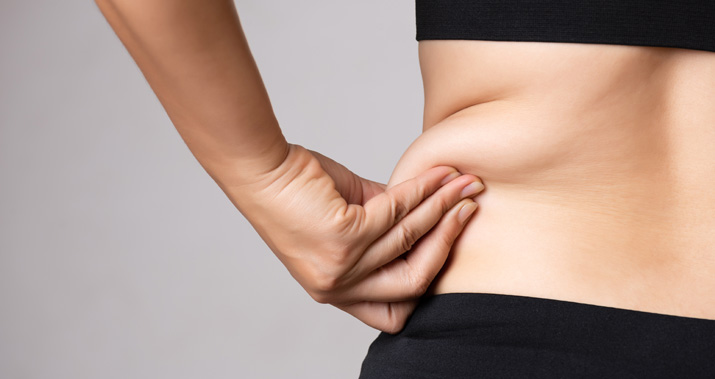
A person’s body fat percentage corresponds to a mathematical formula that calculates the amount of fat contained in the body, while taking into account the difference between fatty and muscular mass. The most common way to calculate this percentage in adults is by using the Deurenberg method, which is based on the criteria of body mass index (BMI), age, gender (0 for female and 1 for male). The formula is: body fat % = (1.2 x BMI) + (0.23 x age) – (10.8 x S) – 5.4
If all of that math feels overwhelming, not to worry. There’s no need to focus on formulas in order to do the actual work of improving one’s body composition. Dropping pounds is, of course, the goal to aim for — however, the fat needs to be reduced all over the body, not just in specifically targeted areas like your belly or your arms. In other words, you need to become calorie deficient. When you come in for a visit at LIWLI our technology will actually measure your fat percentage across different areas of the body including your visceral fat.
Now, before you jump to conclusions that this simply means limiting your caloric intake, you must understand that calorie deficiency doesn’t involve diet alone. To lose fat, you have to burn more calories than you consume. Exercise is key, and not just at the gym – but at all hours during the day, as well. That means, not allowing yourself to be sedentary.
We know what you’re thinking… “But I work at a job where I’m seated all day. How can I find the time in a day to keep working toward my goal of reducing body fat percentage?” Well, we’re glad you asked! Read on for six fitness musts, plus other helpful hints to help you succeed in your weight loss journey.
1. Step It Up
Make a mantra out of these four little words of wisdom imparted by pop-singer Gloria Estefan: “Get on your feet!” That’s right — the simple act of standing could help a 140lb person burn more than 50 extra calories per day! Taking that one step further by adding actual steps can up one’s daily caloric deficit even more! Try to take a brisk walk during the day to really start crushing those calories.
2. Hit the High Intensity Interval Workouts
HIIT, or high-intensity interval training, is a technique which requires you to put in 100% effort through short, intense bursts of exercise, followed by short periods of recovery. This technique keeps your heart rate up, and therefore burns more fat in less time. A sample HIIT workout might consist of 3 rounds of 20 seconds of work, followed by 10 seconds of recovery, and may include sit-ups, jump squats, push-ups, split jumps, tricep dips, jumping jacks, and burpees, among other exercises. Doing interval training every other day will help you to burn more calories week after week, particularly as the continual effort will help you to become more adept at this technique (and less exhausted).
3. Resistance Isn’t Futile
No, of course we don’t mean resist the urge to blow off the gym! The truth is, if you want to preserve muscle while losing weight, you’ll have to do more than just cardio – you’ll need to add some resistance training. Lifting weights is a great way to build muscle strength, which is something you’ll certainly need in order to continue burning calories on the daily. Another benefit of strength training is that it preps your muscles to push even harder during HIIT sessions, which also results in more calories burned. In order to achieve more in a shorter period of time, try focusing on total-body compound movements that work multiple muscle groups simultaneously. Aim for at least three days a week of strength-training.
4. Find Your Focus
Fat-burn, you may be surprised, actually sits at the lower end of the effort scale. Need proof? We burn fat even while we’re sleeping! So, when you’re putting in the effort to lose weight, keep your focus on burning calories, not necessarily on burning fat. Remind yourself that it’s your total caloric expenditure that’s most important, not the type of fuel source you’re using.
5. Diet Habits
Unlike with exercising, mealtimes are when you DO want to be concerned with where your fuel sources are coming from. Rather than strict calorie counting, try focusing on less calorie-dense foods (aka foods that will fill you up due to fiber and water), as opposed to foods that contain empty calories. Half of your plate should contain vegetables, along with fruits and legumes. You should also have adequate protein on your plate, to help maintain lean body mass. The recommended dietary allowance for protein is roughly 0.8 grams per kilogram bodyweight, or about 60g for an average woman.
Also avoid diets that are too restrictive. The last thing you want to do is give up on a diet as a result of feeling deprived or limited. Try the 90/10 rule; a simple concept that has you eating clean, nutrient-dense food 90% of the time, with 10% room left over for indulgences. This encourages a healthy balance, with the freedom to enjoy your favorite foods from time to time, thus making the diet ultimately more sustainable and more realistic; two important factors in the pursuit of any lifestyle-change.
6. Sleep On It
Sleep is a means of exercise-recovery, so it’s an important component to reducing body fat percentage. Sleep helps to reset and reenergize you so you can burn more calories the next day. Don’t skimp on this important factor and resource!
And finally, have patience. On average, losing about one to three percent body fat a month is a realistic goal. Just focus on your interval and strength training, eating clean, and getting adequate sleep. With these active strategies in place, you’ll start to see your body fat percentage go down. On that you can count one hundred percent!